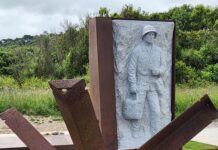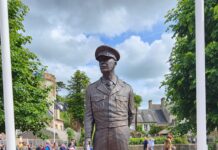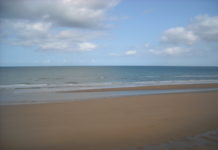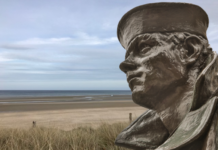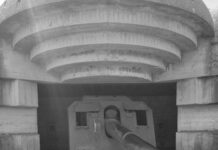Remembering OMAHA BEACH after 75 years
I
On June 6 this year we will celebrate the 75th anniversary of the Western Allies’ assault on Adolf Hitler’s Atlantic Wall, the steel and concrete band of fortifications running along Europe’s Atlantic coastline from the Pyrenees north to the Netherlands, a barrier that he hoped would protect the Third Reich’s western flank from attack. “D-Day,” as this day in history is now commemorated, was one of the decisive battles in WWII, even in modern history, one that will be remembered as long as Marathon, Waterloo and Trafalgar, or for Americans, Yorktown, Gettysburg and Pearl Harbor.
The Allied victory on that day marked the beginning of the end to Hitler’s malignant dream of world domination. A defeat would have brought incalculable consequences, the first and most certain being that there would be no breaching of the Atlantic Wall in 1944—the losses in men and equipment, to say nothing of will, would have been too severe. Freed from its garrison duty in the West, the Wehrmacht might have stalled the Soviet juggernaut on some river in Poland short of the German border and negotiated a division of the spoils. (They had done that before in the 1939 Nazi-Soviet Non-Aggression Pact.) If, on the other hand, the Red Army proved unstoppable, then all of Western Europe would have suffered the fate of Eastern Europe in the immediate post-war era—the establishment of puppet, communist totalitarian states.
How much of this speculation weighed on the Supreme Allied Commander, Gen. Dwight D. Eisenhower, in the evening of June 4 as he paced the mess room of Southwick House—the English country house north of Portsmouth that served as the HQ for SHAEF (Supreme Headquarters, Allied Expeditionary Force)—we will never know exactly, but weigh it did. The window for staging the assault was rapidly closing; deteriorating weather had already forced two postponements. Ships from the invasion fleet already at sea had been recalled once; others were running low on food and fuel oil. (The next window—a full moon with a low tide at dawn—would not again occur until June 18-20, a window during which a nasty storm blew in from the North Atlantic that would have spelled the end of any invasion attempt for 1944.)
Ike, along with his staff and chief commanders, listened to the SHAEF chief meteorologist, RAF Group Captain J. M. Stagg, forecast a 36-hour break in the weather beginning at dawn on June 6. Ike then turned to his commanders to ask for their individual opinions. Most vacillated; only British Field Marshal Bernard L. Montgomery cast a resounding “Go.” Ike hesitated while rain and wind beat against the windows, then turned to the assemblage, saying: “I am quite positive that the order must be given.” Historians have since agreed that Ike made the correct decision, undoubtedly the toughest and most important of his long military career, but one that would lead to near disaster on Omaha Beach.
And so it was—first to the sailors of the invasion fleet, and then to the thousands of restless soldiers penned up in barbed wire “sausage” encampments across southern England, some praying, most gambling, and to the Allied airmen standing by their transports, bombers and fighters. History’s greatest sea and airborne invasion of a fortified enemy coast would commence in the early morning hours of June 6, 1944.
II
If you are fortunate enough to visit Normandy this coming summer to celebrate the 75th anniversary of D-Day, you should arrive prepared for variable weather. If your fortune still holds, you will be able to stroll along the sandy beaches between Colleville-sur-Mer and Vierville-sur-Mer enjoying the gentle breeze and soft sunlight. If you are not so fortunate with the weather, you will probably decline to face the rain sweeping in off the Bay of the Seine, deciding instead to remain automobile bound or hunkered down in some local café with a coffee or beer. You will have the choice.
Seventy-five years ago, the thousands of grossly overladen (carrying 60 or 70 pounds of gear) GIs from the 16th and 116th Regimental Combat Teams (RCTs), seasick, unhappy in their foul-smelling, chemically-treated uniforms specially fitted with extra pockets for all that gear (plus cigarettes), organized into assault-teams and crammed into dozens of landing craft, didn’t have any choice. At dawn on June 6, 1944, high wind carried rain and whipped up four to five foot waves playing havoc with the Neptune plan that meticulously laid out the sequence for the landings on a length of Normandy strand now immortalized as Omaha Beach. Add German artillery, mortar and machine-gun fire to the nasty weather and you had a major disaster in the making for those men, their officers and the entire Allied war effort. And, little was going according to plan at dawn on Omaha Beach.
III
The roads taken to this defining moment had been very different for the first wave of GIs from the 16th and 116th RCTs being carried inexorably toward the beach in their 30’-40’, flat-bottomed American LCVPs (Landing Craft, Vehicle, Personnel) and British LCAs (Landing Craft, Attack).
The 16th Infantry, one of the three regiments forming the 1st U.S. Infantry Division (ID) had arrived in England on August 7, 1942, after a week at sea. Barely two months later, the division, as part of Operation Torch, landed in North Africa where it fought for the next seven months. When the combined British Eighth Army (Montgomery) and the American II Corps (Patton) finally forced the surrender of Generallutnant Erwin Rommel’s Panzerarmee Afrika in 1943, the “Big Red One” became part of Operation Husky, the July 1943 invasion of Sicily. After the fighting in Sicily ended that fall, the division sailed for England for rest and rebuilding (a rebuilding effort that had to accommodate the breaking in of both a new commander and assistant commander to replace Gens. Terry L. Allen and Theodore Roosevelt, Jr., both of whom Gen. Omar N. Bradley had sacked for not adequately disciplining their men). While in England, Operation Neptune planners chose the reorganized 16th Infantry to spearhead the D-Day assault on the eastern sectors of Omaha Beach, trailed by the 18th and 26th RCTs, also from the 1st ID.
Meanwhile, the 29th Infantry Division, of which the 116th Infantry was a part, experienced the first two years of WWII in a very different way. Nicknamed the “Blue and Gray” division and using a blue and gray version of the Korean monad for its shoulder patch, it was comprised of the National Guards of Virginia, Maryland, Pennsylvania and the District of Columbia. The 116th Infantry proudly traced its linage to the famous Civil War “Stonewall Brigade” that had fought under Confederate Gen. Thomas “Stonewall” Jackson. On October 5, 1942, the 29th had shipped out for England aboard the ocean liner Queen Mary. Steaming at high speed as she approached the British Isles, the liner managed to ram the British cruiser Curacao sent to escort her into port with the loss of 332 limey seamen. It was an inauspicious beginning to a long, mostly dreary stay in wartime England.
Of the three types of divisions deployed by the U.S. Army in WWII, Regular, National Guard and Draftee, the National Guard units were the least favored by the regular officers who ran the army. They thought that National Guard officers were generally too old, in poor physical condition and too clubby with their men to be effective combat leaders. The units were too poorly equipped and the enlisted men too poorly trained to constitute effective combat forces. Thus, the 29th ID was held out of combat in 1942 and ’43, relegated to seemingly endless rounds of training in the English countryside with the only breaks being the occasional weekend pass to visit London where many of the small-town GIs lived it up.
The men of the 29th became the Army’s lab rats, the first to test training procedures before being moved to another base for more training. Lt. Charles R. Cawthon, commanding Company H (116th Infantry) remembered that the cycle began immediately after their arrival in England with 30-mile marches across a soggy Salisbury Plain, the halfway point being a swing around Stonehenge. The 116th Infantry also trained at the Assault Training Centers at Wollacombe in North Devon, at Slapton Sands facing the Channel and at places in between. A good deal of that activity took place under live fire; Stonewallers died. This constant training took place under the vigilant eyes of two West Pointers, Col. Charles D. W. Canham and Maj. Gen. Charles W. Gerhardt, both stern disciplinarians. Of Canham, his regimental commander, Cawthon later wrote: “I never heard him laugh, but he could smile.” Stephen E. Ambrose, in his history of D-Day, quotes another Stonewaller, Pfc. Felix Branham, who remembered hearing Gerhardt admonishing Canham for being too hard on his men. “Goddamn it Charles,” Canham fired back, “This is my regiment and I’m the one commanding it.” Branham thought his commanding officer eased up after that exchange, but not much! Gerhardt could be a martinet in his own right. After coming ashore on the afternoon of D-Day to establish his command post, he reportedly chewed out a hapless GI for littering because he had dropped an orange peel on the beach.






